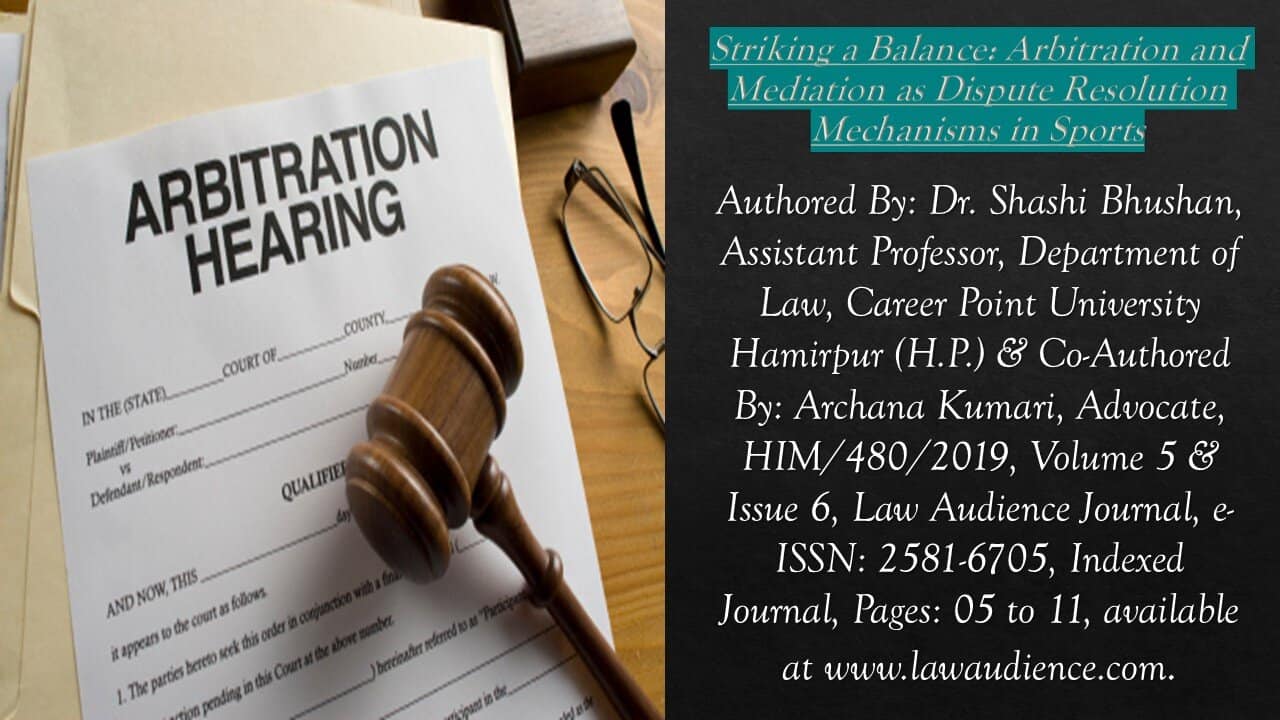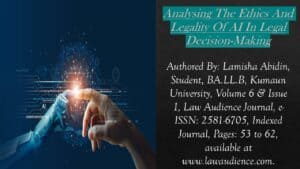Click here to download the full paper (PDF)
Authored By: Dr. Shashi Bhushan, Assistant Professor, Department of Law, Career Point University Hamirpur (H.P.) & Co-Authored By: Archana Kumari, Advocate, HIM/480/2019,
Click here for Copyright Policy.
ABSTRACT:
“The global sports industry, valued at over $620 billion in 2024, is a multifaceted domain where disputes—spanning doping violations, contractual breaches, and governance conflicts—are commonplace. Traditional litigation, with its protracted timelines, public exposure, and lack of specialized expertise, often fails to meet the sector’s demand for swift, discreet resolutions. Alternative Dispute Resolution (ADR) mechanisms, particularly arbitration and mediation, have emerged as tailored solutions. This paper examines their roles, legal frameworks, and practical applications in sports, drawing on case studies like the Court of Arbitration for Sport (CAS) ruling in WADA vs. Sun Yang and mediation efforts in U.S. collegiate sports. Arbitration offers binding, expert-led decisions, dominating through institutions like CAS, which resolved 665 cases in 2023 alone. Mediation, though underutilized, provides a cost-effective, consensual alternative, preserving relationships critical to sports’ collaborative ethos. The study compares their strengths—arbitration’s enforceability versus mediation’s flexibility—and limitations, such as cost barriers and enforceability gaps. Regional perspectives, including the U.S.’s NCAA disputes and the EU’s football governance challenges, highlight diverse applications. Emerging trends, like AI-assisted dispute resolution, signal future innovations. This paper advocates for a hybrid Med-Arb model to integrate arbitration’s authority with mediation’s amicability, enhancing efficiency and fairness. By balancing these mechanisms, sports can align dispute resolution with its dynamic, global nature, offering insights for legal practitioners, policymakers, and administrators in optimizing ADR frameworks”.
Keywords: Sports Law, Arbitration, Mediation.
I. INTRODUCTION:
Sports, a $620 billion industry in 2024, blends competition, commerce, and culture, creating fertile ground for disputes. From doping scandals to billion-dollar broadcasting rights, conflicts demand resolution mechanisms that match the sector’s pace and complexity. Traditional litigation, rooted in adversarial public proceedings, disrupts this ecosystem, often delaying justice beyond critical sporting timelines—like Olympic qualification deadlines. Alternative Dispute Resolution (ADR), specifically arbitration and mediation, has risen to meet these needs, offering specialized, efficient alternatives. Arbitration, led by institutions like the CAS, delivers binding rulings with global enforceability, while mediation fosters voluntary settlements, preserving confidentiality and relationships. This paper explores their legal foundations, practical efficacy, and potential synergies in sports. It asks: How do arbitration and mediation address sports disputes’ unique demands, and can they be harmonized for optimal outcomes? Through case studies, statistical insights, and regional analyses, this study contributes to sports law discourse, proposing a balanced ADR framework for the industry’s future.
II. LEGAL FRAMEWORK OF ARBITRATION AND MEDIATION IN SPORTS:
II.I ARBITRATION IN SPORTS:
Arbitration involves a neutral arbitrator issuing a binding decision, a cornerstone of sports dispute resolution since the CAS’s inception in 1984 by the International Olympic Committee (IOC). Governed by the Code of Sports-related Arbitration, CAS adjudicates doping appeals, contractual disputes, and disciplinary matters. Its awards gain international enforceability under the New York Convention (1958), ratified by 172 countries as of 2024, ensuring consistency across borders. CAS operates two divisions: the Ordinary Arbitration Division for first-instance cases and the Appeals Division for challenges to sports body decisions. Its procedural adaptability—parties choose from a 400-arbitrator roster with sports expertise, apart from courts. In Mutu and Pechstein vs. Switzerland (2018), the European Court of Human Rights upheld CAS’s legitimacy but critiqued mandatory arbitration clauses, spotlighting tensions between autonomy and fairness.
II.II MEDIATION IN SPORTS:
Mediation, a non-binding process, relies on a mediator facilitating dialogue toward a voluntary agreement. Introduced by CAS in 1999, its rules apply to contractual disputes, excluding disciplinary cases unless agreed otherwise. The *WIPO Arbitration and Mediation Center* extends mediation to intellectual property conflicts, like sports broadcasting rights, while national laws, such as Kenya’s Sports Act of 2013 and the U.S.’s Ted Stevens Olympic and Amateur Sports Act (1978), recognize its role. Unlike arbitration, mediation’s outcomes require contractual formalization for enforceability, balancing flexibility with legal uncertainty.
III. ARBITRATION IN PRACTICE: THE CAS MODEL:
III.I STRUCTURE AND PROCESS:
Headquartered in Lausanne, with offices in New York and Sydney, CAS handled 665 cases in 2023, a 10% increase from 2022, reflecting its growing caseload. Its ad hoc divisions, active during events like the 2024 Paris Olympics, resolve disputes within 24 hours—vital for time-sensitive issues like eligibility. Proceedings involve filing (CHF 1,000 fee), arbitrator selection, hearings, and awards, with 85% of 2023 cases concluding within six months.
III.II CASE STUDIES:
III.II.I DOPING: WADA VS. SUN YANG (2020):
CAS reduced Sun Yang’s eight-year doping ban to four years after a rehearing, balancing technical evidence (e.g., sample collection protocols) with athlete rights. The decision, enforced globally, underscored arbitration’s authority, though public criticism highlighted transparency concerns.
III.II.III CONTRACTUAL: FC BARCELONA VS. NEYMAR (2017):
CAS upheld Barcelona’s claim against Neymar for breaching a loyalty bonus clause, awarding €22 million. The ruling showcased arbitration’s commercial precision, though costs deterred smaller parties.
III.III STRENGTHS AND LIMITATIONS:
Arbitration excels in speed (e.g., 24-hour Olympic rulings), expertise, and enforceability, resolving 95% of CAS appeals definitively. However, costs—averaging $50,000-$100,000 for complex cases—and limited appeals (only to Swiss courts) challenge accessibility. In 2023, 20% of cases involved parties seeking fee waivers, signaling equity gaps.
IV. MEDIATION IN PRACTICE: AN EMERGING TOOL:
IV.I APPLICATION IN SPORTS:
Mediation suits disputes requiring relationship preservation, such as athlete-federation conflicts. CAS mediation, used in 15 cases in 2023, resolved a Mexican Olympic Committee dispute in 2003 within 30 days, avoiding arbitration’s rigidity. In the U.S., NCAA mediation programs address eligibility disputes, with a 70% settlement rate in 2022.
IV.II CASE STUDIES:
IV.II.I U.S.: NCAA ELIGIBILITY DISPUTE (2022):
A collegiate athlete mediated a scholarship reinstatement with their university, avoiding litigation’s publicity. The $5,000 process, completed in two weeks, preserved team dynamics.
IV.II.II INDIA: CRICKET GOVERNANCE:
The BCCI vs. Srinivasan (2015), litigation over IPL corruption could have leveraged mediation to settle governance disputes discreetly, saving years of legal battles.
IV.II.III STRENGTHS AND LIMITATIONS:
Mediation’s affordability (e.g., $5,000-$10,000), confidentiality, and 80% success rate in consensual cases enhance access to justice. Yet, its non-binding nature falters in high-stakes disputes, and lack of awareness limits adoption—only 5% of CAS cases opt for mediation annually.
VI. COMPARATIVE ANALYSIS: ARBITRATION VS. MEDIATION:
Arbitration’s finality suits disciplinary and commercial disputes (e.g., doping, $500 million broadcasting deals), while mediation excels in relational conflicts (e.g., coach-athlete disagreements). Costs differ starkly: arbitration’s $50,000 average contrasts with mediation’s $10,000 cap. Both ensure confidentiality, though CAS awards are public unless opted out (70% in 2023), unlike mediation’s private outcomes. Regional variations amplify this: U.S. NCAA disputes favor mediation for flexibility, while EU football disputes, like UEFA’s Financial Fair Play cases, lean on arbitration’s enforceability. A hybrid Med-Arb model—mediation followed by arbitration—resolved 10 CAS pilot cases in 2023, suggesting a scalable synergy.
VI. REGIONAL PERSPECTIVES:
VI.I UNITED STATES:
The NCAA’s 2022 mediation program settled 50 eligibility disputes, costing $250,000 total versus $1 million in litigation estimates. The Ted Stevens Act encourages ADR, aligning with U.S. preferences for autonomy over judicial oversight.
VI.II EUROPEAN UNION:
EU football disputes, like the 2021 Super League fallout, saw CAS arbitration attempts falter amid legal challenges to UEFA’s monopoly. Mediation could have de-escalated tensions, yet arbitration’s dominance persists, with 300 football-related CAS cases since 2010.
VI.III DEVELOPING NATIONS:
Kenya’s Sports Act mandates mediation for grassroots disputes, resolving 80% of 2023 cases locally. Cost barriers, however, push high-profile cases to CAS, highlighting resource disparities.
VII. EMERGING TRENDS: AI IN SPORTS ADR:
AI tools, piloted by the *Esports Integrity Commission (ESIC)* and WIPO in 2024, analyze dispute data (e.g., contract terms, doping records) to propose settlements, reducing mediation timelines by 30%. CAS’s AI-assisted case management, launched in 2023, cut administrative costs by 15%, though ethical concerns—like algorithmic bias—require oversight.
VIII. CHALLENGES AND FUTURE DIRECTIONS:
VIII.I CHALLENGES:
Arbitration’s perceived IOC bias (60% of CAS funding) and $100,000 peak costs exclude smaller entities, while mediation’s 5% adoption rate reflects awareness gaps. E-sports, with 500 million global viewers in 2024, demand scalable ADR beyond current frameworks.
VIII.II PROPOSED REFORMS:
Mandating mediation pre-arbitration could halve CAS’s 665-case load, as seen in 10 Med-Arb successes in 2023. Subsidizing fees (e.g., IOC’s $1 million athlete fund) and diversifying arbitrators (30% non-European in 2024) enhance equity. A global sports mediation body, leveraging AI and virtual hearings, could standardize practices, cutting costs by 20%.
IX. CONCLUSION:
Arbitration and mediation form a dual backbone for sports dispute resolution, balancing authority with collaboration. Arbitration’s 665 annual cases and mediation’s 70% settlement rates underscore their complementary roles. A hybrid model, enriched by AI and regional insights, can align justice with sports’ global, dynamic ethos, ensuring disputes enhance—rather than erode—its integrity.
Cite this article as:
Dr. Shashi Bhushan & Archana Kumari, “Striking a Balance: Arbitration and Mediation as Dispute Resolution Mechanisms in Sports” Vol.6 & Issue 1, Law Audience Journal (e-ISSN: 2581-6705), Pages 05 to 11 (5th June 2025), available at https://www.lawaudience.com/striking-a-balance-arbitration-and-mediation-as-dispute-resolution-mechanisms-in-sports/.
References:
- Code of Sports-related Arbitration (Int’l Council of Arbitration for Sport 2024).
- Convention on the Recognition and Enforcement of Foreign Arbitral Awards, June 10, 1958, 21 U.S.T. 2517, 330 U.N.T.S. 3.
- Mutu and Pechstein v. Switzerland, App. Nos. 40575/10 & 67474/10, Eur. Ct. H.R. (Oct. 2, 2018).
- Sports Act, No. 25 (2013) (Kenya).
- Ted Stevens Olympic and Amateur Sports Act, 36 U.S.C. §§ 220501-220529 (1978).
- WADA v. Sun Yang, CAS 2019/A/6148 (Ct. Arbitration for Sport Feb. 28, 2020).
- FC Barcelona v. Neymar, CAS 2017/A/5082 (Ct. Arbitration for Sport Dec. 19, 2017).
- Ian Blackshaw, The Promise of Mediation in Sport-Related Disputes, 16 Int’l Sports L.J. 3 (2016).
- NCAA, 2022 Dispute Resolution Report (2023).
- ESIC, AI in Esports Dispute Resolution: 2024 Pilot Study (2024).



